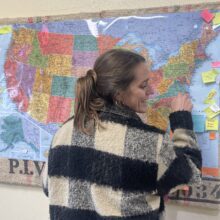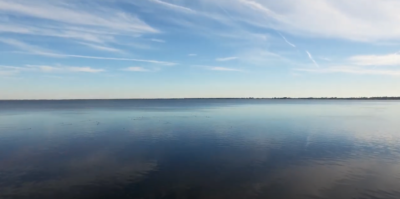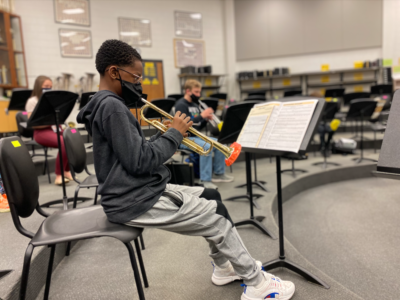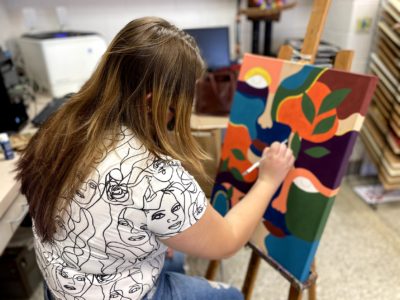Nearly every course in school had to change this year, but band may have been one of the most drastic in terms of daily operation. Vevlyn Lowe is a 25-year music educator and has been the band director at Sampson Middle School for 22 of those years. Prior to COVID-19, she would expect to have anywhere from 80 to 100 sixth graders beginning their first band class. This school year, she had 41 sign up in total. Last year, she had 56 in one class period alone.
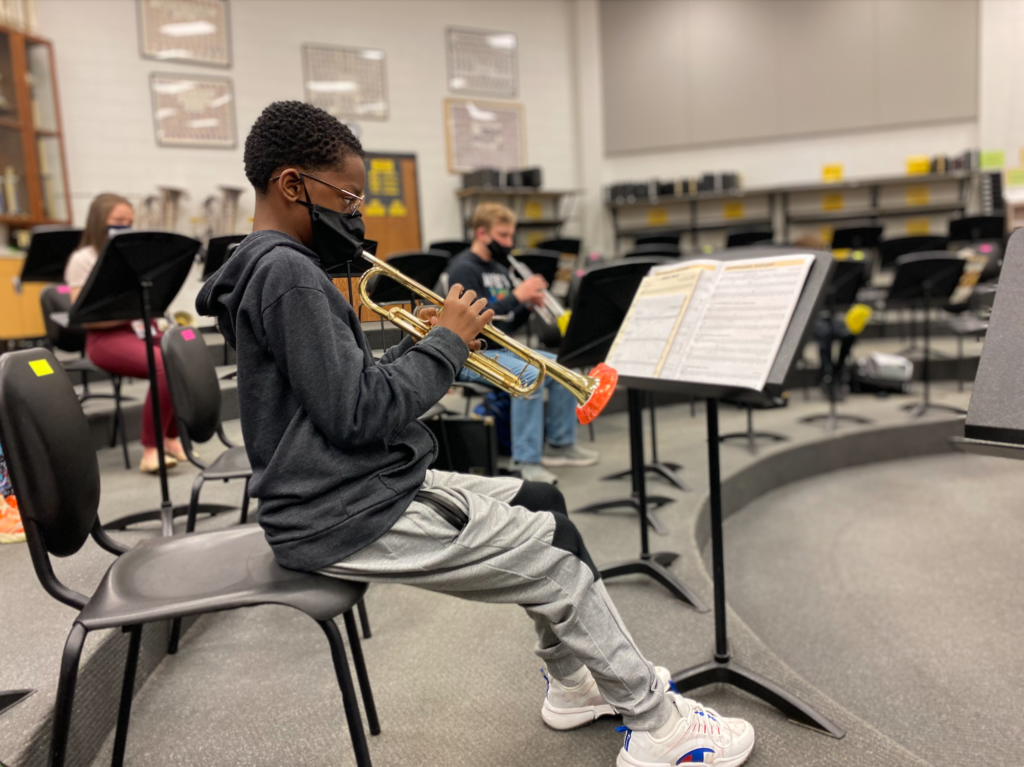
Lowe can understand the hesitation by parents during the pandemic.
“I believe they were scared because when we play a band instrument, you have to use air. You know, play a brass instrument or a woodwind, and we know how COVID-19 spreads — I understand their fear,” she said.
So, what does band class look like during a pandemic? For any instrument that needs air to make sound, it starts with a special mask. The mask has an opening in the middle for a mouth piece, so a brass player doesn’t have to move their mask to play, for example. Trumpets, trombones, and tubas have bell covers, which act as masks for instruments. For flute players, a face shield with a special cutout allows the student to hold the instrument at the proper angle.
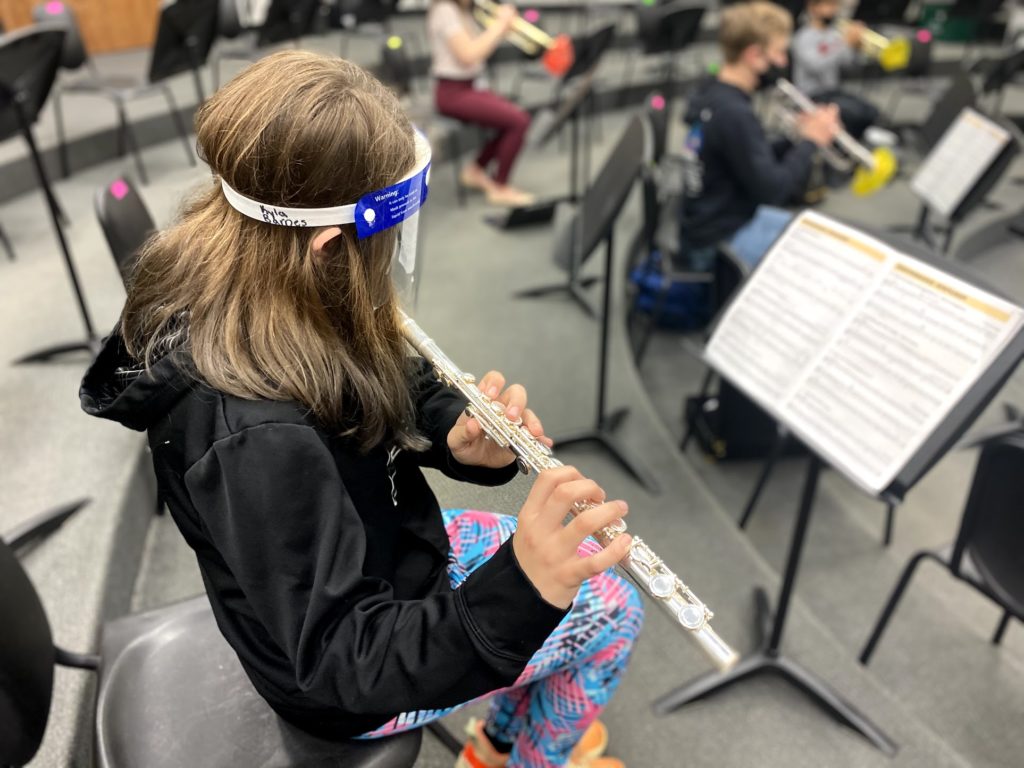
How much of a difference does music education make in the life of a student? A lot, said Sampson Middle School principal Robert Turlington. He has seen how a student’s trajectory can change after joining Lowe’s band program and the impact it has on their progress in other classes.
Lowe is worried, like many other art educators, that because their classes are electives, they are not thought of as necessary curriculum. And in a year where students may be falling behind, it’s electives that could get dropped when students need to retake core classes in order to graduate.
During her more than two decades at the school, Lowe has opened the door to music for her students, Turlington said.
“A lot of people want their children to be involved with Mrs. Lowe because they see their child change,” he said.
He also said her success is consistent — year after year students thrive in her band classes.
“She knows how invaluable it is to have that expression. To be able to express music and to unlock what could be potential for that right side of the brain to flourish.”
Robert Turlington, principal at Sampson Middle School
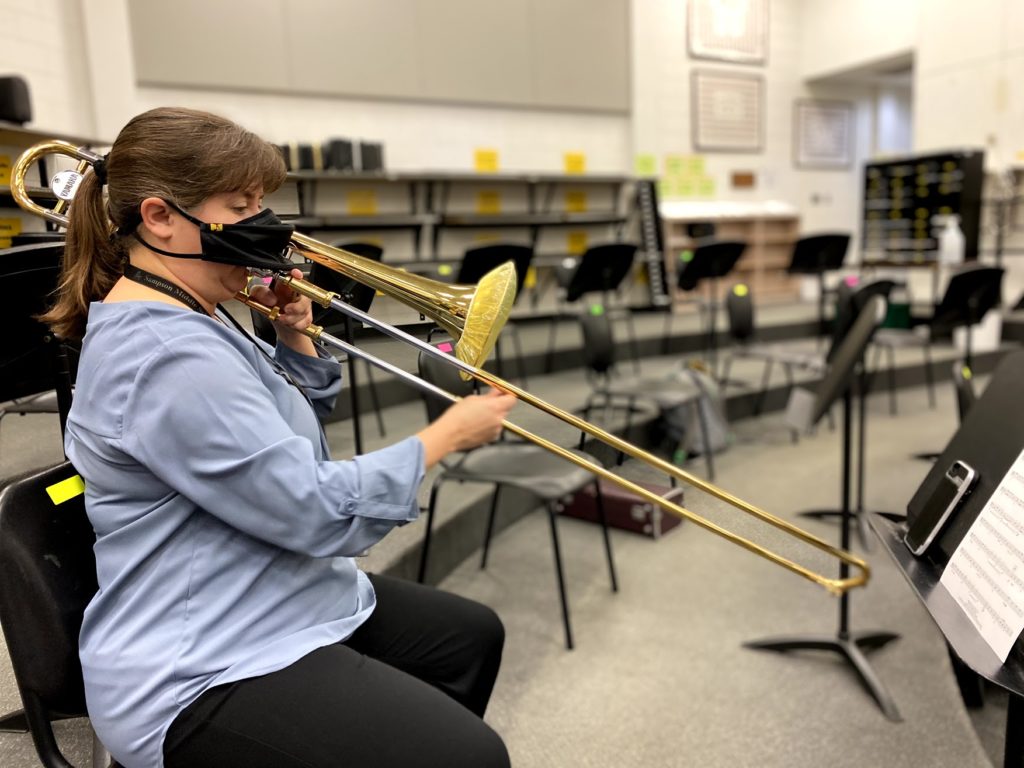
The making of a notable band director
Lowe grew up in Chowan County in northeastern North Carolina. She traveled 22 miles to get to John A. Holmes High School in Edenton, where her love for music thrived. She believes she was fortunate to have a band director who identified her knack for music. Outside of school, she took piano lessons from a pastor at a local church.
“I knew when I graduated from high school I wanted to do something with music. There was never any question about that, I was going to major in music.”
Vevlyn Lowe, band director at Sampson Middle School
Lowe went to East Carolina University and majored in music education. She then went on to receive her master’s degree from Florida State University. Her husband, who is also a band director, was part of the North Carolina Teaching Fellows program and found a teaching position in Sampson County. After she finished her master’s program, she headed to the area. They have been working there since.
When we visited Lowe’s sixth grade band class in March, she had six students for in-person instruction and many others joining virtually. She and her student teacher, Kaitlyn Havican, had the schedule projected onto the board, with SmartMusic assignments and Google Meet times. Every week, Havican adds an animal with an instrument to the slide, getting students to guess what the new combination might be.
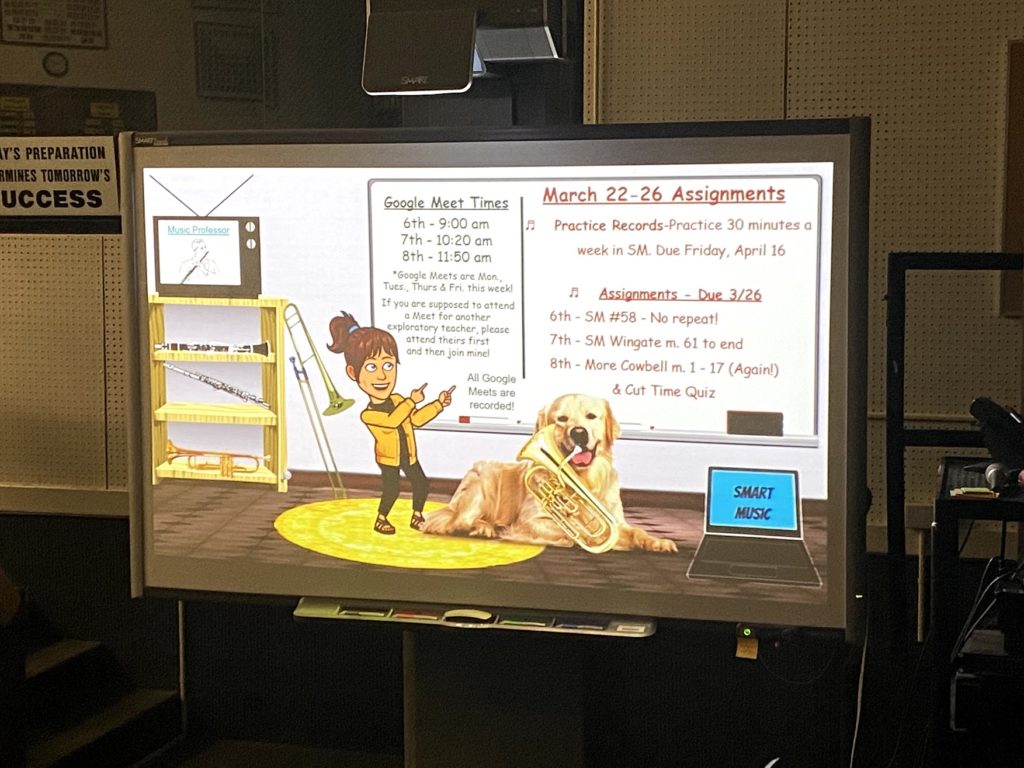
During our visit, it is a golden retriever with a baritone. Havican says it’s a fun way to start class, and it introduces instruments students may not see otherwise. Students call out guesses and say what has been their favorite in the past. There was an octopus with a piccolo and even Mario — from the famed Nintendo video game — with a tuba.
Band class before COVID-19
In the mornings before March 2020, Lowe’s main task was monitoring band room flow before the start of school. With six different band classes marching in to store instruments and use computers to complete SmartMusic assignments, controlling student traffic was a big job. Students would drop off money they had collected for the many fundraisers Lowe orchestrated throughout the year. But the early morning hustle and bustle has changed dramatically for the band director.
Lowe was used to seeing her band students five days a week. This year the school is working on a hybrid schedule, so she sees anywhere from four to 15 students for each of her classes twice a week. For sixth grade students who are picking up an instrument for the first time, virtual instruction can be challenging.
In a typical year, beginning band students see a lot of modeling and demonstrating from Lowe. Embouchure — the forming of the mouth around a mouth piece — is one of the building blocks for brass and wind instruments. Masks make this instruction challenging. And for those students who are fully virtual, it is difficult for Lowe to troubleshoot with them.
Another huge part of Lowe’s program is early recruitment. In typical years, she heads to the elementary school in April with some of her eighth grade band players, and they show the incoming sixth graders what their next year could look like if they choose to join band. The older students play and answer questions from the younger students. The idea, Turlington said, is to “let them hear what they can become.” This year, Turlington hired a substitute teacher for band class for a day so that Lowe can still go to the elementary school to drum up excitement.
Band class during COVID-19
One tradition Lowe worked to keep in place this year was the winter band concert. She presented a plan to school administration on how she could do it safely, and they approved. The sixth, seventh, and eighth grade students played with their respective grades in the gym, 6 feet apart. The concert was livestreamed for parents and families who sat in the parking lot or at home, and only band players and administration helping with tech were allowed in the gym. It was the first time her sixth grade students played all together with their peers.
Lowe also began participating in the North Carolina Symphony’s Adopt-a-School program, where a musician works directly with students to help in different ways, virtually, in the classroom. Lowe’s school has partnered with Rachel Niketopoulos, who plays the French horn with the North Carolina Symphony. So far, they have had a virtual question-and-answer session, a lesson on “buzzing” with student brass players, an introduction to the French horn for one student, and Niketopoulos helped an eighth grade student with their One State One Score submission.
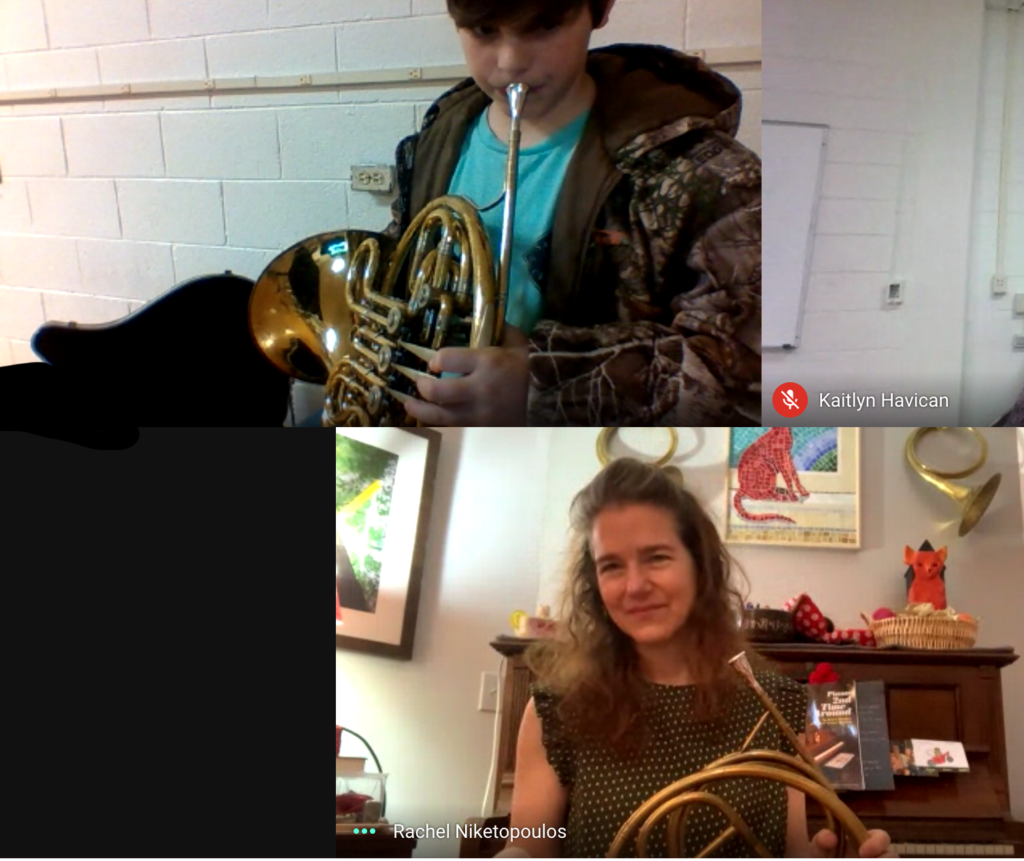
Where other people wouldn’t engage, Lowe figured out a way to work within the new confines of school, said Turlington. In a virtual environment, she still had students qualify for the All-State Honors Band.
“It’s just incredible that you can do these types of things, in an environment where you don’t have half of your students with you, or more so,” he said.
What is another hurdle Lowe helps her students clear? The potential financial burden of purchasing their instrument. If a student can’t afford one, Lowe finds a way to make it happen — she has the community help fund it or she seeks out used instruments that are sitting in past band students’ closets.
Lowe is also in the early stages of starting a program called the Dark Horse Fellows, a teacher preparatory program for rising high school juniors and seniors intended to help create a teacher pipeline for Clinton City Schools. The goal is to recruit students who know they are interested in becoming educators and invest in them as they return back to the community.
Lowe sees the value in growing up in a rural place and making her home in one after going away to college. She is an example for everyone at Sampson Middle School, Turlington said, and everyone thinks highly of her and her program.
“She’s always concerned about the music program at our school. Very laser-focused on making sure that this is at the pinnacle that it can be, and that everybody who has the possibility to play an instrument gets an instrument in their hand.”
Robert Turlington, principal of Sampson Middle School

